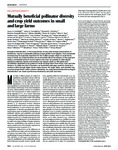Por favor, use este identificador para citar o enlazar este ítem:
http://www.alice.cnptia.embrapa.br/alice/handle/doc/1035104Registro completo de metadatos
| Campo DC | Valor | Lengua/Idioma |
|---|---|---|
| dc.contributor.author | GARIBALDI, L. A. | pt_BR |
| dc.contributor.author | CARVALHEIRO, L. G. | pt_BR |
| dc.contributor.author | VAISSIÈRE, B. E. | pt_BR |
| dc.contributor.author | GEMMILL-HERREN, B. | pt_BR |
| dc.contributor.author | HIPÓLITO, J. | pt_BR |
| dc.contributor.author | FREITAS, B. M. | pt_BR |
| dc.contributor.author | NGO, H. T. | pt_BR |
| dc.contributor.author | AZZU, N. | pt_BR |
| dc.contributor.author | SÁEZ, A. | pt_BR |
| dc.contributor.author | ASTROM, J. | pt_BR |
| dc.contributor.author | AN, J. | pt_BR |
| dc.contributor.author | BLOCHTEIN, B. | pt_BR |
| dc.contributor.author | BUCHORI, D. | pt_BR |
| dc.contributor.author | CHAMORRO GARCÍA, F. J. | pt_BR |
| dc.contributor.author | SILVA, F. O. da | pt_BR |
| dc.contributor.author | DEVKOTA, K. | pt_BR |
| dc.contributor.author | RIBEIRO, M. de F. | pt_BR |
| dc.contributor.author | FREITAS, L. | pt_BR |
| dc.contributor.author | GAGLIANONE, M. C. | pt_BR |
| dc.contributor.author | GOSS, M. | pt_BR |
| dc.contributor.author | IRSHAD, M. | pt_BR |
| dc.contributor.author | KASINA, M. | pt_BR |
| dc.contributor.author | PACHECO FILHO, A. J. S. | pt_BR |
| dc.contributor.author | KIILL, L. H. P. | pt_BR |
| dc.contributor.author | KWAPONG, P. | pt_BR |
| dc.contributor.author | NATES PARRA, G. | pt_BR |
| dc.contributor.author | PIRES, C. S. S. | pt_BR |
| dc.contributor.author | PIRES, V. | pt_BR |
| dc.contributor.author | RAWAL, R. S. | pt_BR |
| dc.contributor.author | RIZALI, A. | pt_BR |
| dc.contributor.author | SARAIVA, A. M. | pt_BR |
| dc.contributor.author | VELDTMAN, R. | pt_BR |
| dc.contributor.author | VIANA, B. F. | pt_BR |
| dc.contributor.author | WITTER, S. | pt_BR |
| dc.contributor.author | ZHAN, H. | pt_BR |
| dc.date.accessioned | 2016-01-26T11:11:11Z | pt_BR |
| dc.date.available | 2016-01-26T11:11:11Z | pt_BR |
| dc.date.created | 2016-01-26 | pt_BR |
| dc.date.issued | 2016 | pt_BR |
| dc.identifier.citation | Science, v. 351, n. 6271, p. 388-391, 2016. | pt_BR |
| dc.identifier.issn | 1095-9203 | pt_BR |
| dc.identifier.uri | http://www.alice.cnptia.embrapa.br/alice/handle/doc/1035104 | pt_BR |
| dc.description | Ecological intensification, or the improvement of crop yield through enhancement of biodiversity, may be a sustainable pathway toward greater food supplies. Such sustainable increases may be especially important for the 2 billion people reliant on small farms, many of which are undernourished, yet we know little about the efficacy of this approach. Using a coordinated protocol across regions and crops, we quantify to what degree enhancing pollinator density and richness can improve yields on 344 fields from 33 pollinator-dependent crop systems in small and large farms from Africa, Asia, and Latin America. For fields less than 2 hectares, we found that yield gaps could be closed by a median of 24% through higher flower-visitor density. For larger fields, such benefits only occurred at high flower-visitor richness. Worldwide, our study demonstrates that ecological intensification can create synchronous biodiversity and yield outcomes. | pt_BR |
| dc.language.iso | eng | eng |
| dc.rights | openAccess | eng |
| dc.subject | Visitantes florais | pt_BR |
| dc.subject | Grande fazenda | pt_BR |
| dc.subject | Pequena fazenda | pt_BR |
| dc.subject | Pollinator diversity | pt_BR |
| dc.title | Mutually beneficial pollinator diversity and crop yield outcomes in small and large farms. | pt_BR |
| dc.type | Artigo de periódico | pt_BR |
| dc.date.updated | 2016-04-05T11:11:11Z | pt_BR |
| dc.subject.thesagro | Polinização | pt_BR |
| dc.subject.thesagro | Biodiversidade | pt_BR |
| riaa.ainfo.id | 1035104 | pt_BR |
| riaa.ainfo.lastupdate | 2016-04-05 | pt_BR |
| dc.identifier.doi | 10.1126/science.aac7287 | pt_BR |
| dc.contributor.institution | LUCAS A. GARIBALDI, Instituto de Investigaciones en Recursos Naturales; LUÍSA G. CARVALHEIRO, UnB; BERNARD E. VAISSIÈRE, Institut national de la recherche agronomique; BARBARA GEMMILL-HERREN, FAO; JULIANA HIPÓLITO, Universidade Federal da Bahia; BRENO M. FREITAS, Universidade Federal do Ceará; HIEN T. NGO, Intergovernmental Platform on Biodiversity and Ecosystem Services (IPBES); NADINE AZZU, FAO; AGUSTÍN SÁEZ, Universidad Nacional del Comahue-CONICET; JENS ASTROM, Norwegian Institute for Nature Research; JIANDONG AN, Institute of Apicultural Research, Chinese Academy of Agricultural Sciences; BETINA BLOCHTEIN, Pontifícia Universidade Católica do Rio Grande do Sul (PUCRS); DAMAYANTI BUCHORI, Department of Plant Protection, Faculty of Agriculture, Bogor Agricultural University; FERMÍN J. CHAMORRO GARCÍA, Universidad Nacional de Colombia; FABIANA OLIVEIRA DA SILVA, Universidade Federal de Sergipe; KEDAR DEVKOTA, Institute of Agriculture and Animal Science; MARCIA DE FATIMA RIBEIRO, CPATSA; LEANDRO FREITAS, Jardim Botânico do Rio de Janeiro (JBRJ); MARIA C. GAGLIANONE, Laboratório de Ciências Ambientais, Universidade Estadual do Norte Fluminense Darcy Ribeiro; MARIA GOSS, University of Zimbabwe, Faculty of Agriculture, Crop Science Department; MOHAMMAD IRSHAD, Conservation and Management of Pollinators for Sustainable Agriculture through Ecosystem Approach project; MUO KASINA, Agricultural and Livestock Research Organisation-Sericulture; ALÍPIO J. S. PACHECO FILHO, Universidade Federal do Ceará; LUCIA HELENA PIEDADE KIILL, CPATSA; PETER KWAPONG, College of Agriculture and Natural Sciences, School of Biological Sciences, University of Cape Coast; GUIOMAR NATES PARRA, Universidad Nacional de Colombia; CARMEN SILVIA SOARES PIRES, CENARGEN; VIVIANE PIRES, Instituto do Meio Ambiente e Recursos Hídricos; RANBEER S. RAWAL, G.B. Pant Institute of Himalayan Environment and Development, Kosi-Katarmal; AKHMAD RIZALI, Department of Plant Pest Diseases, Faculty of Agriculture, University of Brawijaya; ANTONIO M. SARAIVA, Universidade de São Paulo, Escola Politécnica; RUAN VELDTMAN, South African National Biodiversity Institute, Kirstenbosch Research Centre; BLANDINA F. VIANA, Universidade Federal da Bahia; SIDIA WITTER, Centro de Pesquisa Emílio Schenk, Fundação Estadual de Pesquisa Agropecuária; HONG ZHAN, Institute of Apicultural Research, Chinese Academy of Agricultural Sciences. | pt_BR |
| Aparece en las colecciones: | Artigo em periódico indexado (CPATSA)  | |
Ficheros en este ítem:
| Fichero | Descripción | Tamaño | Formato | |
|---|---|---|---|---|
| Kiill2016.pdf | 455,71 kB | Adobe PDF |  Visualizar/Abrir |









